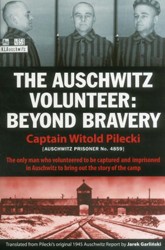A strange title for a Holocaust memoir — aren’t all such memoirs stories of survival? — yet it seems peculiarly appropriate here. In experience after experience as they are recounted in horrific detail the expected outcome was death and yet Sam Pivnik survived — credited by the author himself to an almost superhuman will to live.
The Germans invaded Sam’s town of Bedzin, Poland on his 13th birthday in 1939. Between then and liberation in 1945 Sam had been in two ghettos, several labor camps, concentration camps and on the final death march from Poland to Germany as the Nazis were retreating. In 1943 when very ill with Typhus he had a high fever, he writes: “ the will to survive drove me on, made it possible for me to get out of my bunk bed and stand to attention with the other patients the day that Mengele came….” He continues, “ to this day I don’t know why” but Mengele reversed his decision — the finger pointing left (to the gas chambers) — and Sam was allowed to stay in his bunk and recover.
Born into a loving family in a town that was more than 50 percent Jewish Sam remembers a childhood of relative tranquility that vanished with the arrival of the Germans. While the living conditions in the ghetto were quite desperate most of his family managed to stay together until the summer of 1943 when the ghetto was “liquidated”. What follows is the nightmarish moment of separation when Sam’s mother pushes him to the men’s line with the words “Szlamek, save yourself”. He is never to see them again.
Sam details the chain of command of the work force to which he is assigned and once he becomes a foreman he is no longer at the bottom. He gets better food but it doesn’t last long. Along the way he suffers beatings, learns about how “camp politics worked” and participates under orders in the killing of men who had attempted to escape. Sam tells all — no whitewashing of his role.
As the Germans face defeat those in charge of prisoners in Poland begin their retreat to Germany by foot — only, in contrast to the prisoners, they are well clothed and well-shod. Surviving the “Death March” Sam is liberated by the British.
The story is fleshed out with facts that Pivnik researched to convey the life that was lost as well as the horrors endured. The text includes archival photographs of Bedzin, German officers, ghetto life, concentration camps and some personal photos — including his post-war return to visit Bezdin many years later Sam found his brother Nathan after liberation, made his way to Palestine and ultimately they both settled in England where he became an art dealer. It seemed incredible to this reviewer that the author at an advanced age could produce this mesmerizing document of his experiences. The Notes at the end of the book reveal that the book was actually “ghost-written.” Based on a series of taped interviews which had been recorded by Sam’s friend Mei Trow, a historian has captured Sam Pivnik’s “voice. The historical framework woven into the story gives the book an additional significance. A glossary of Yiddish and German words is also helpful.



